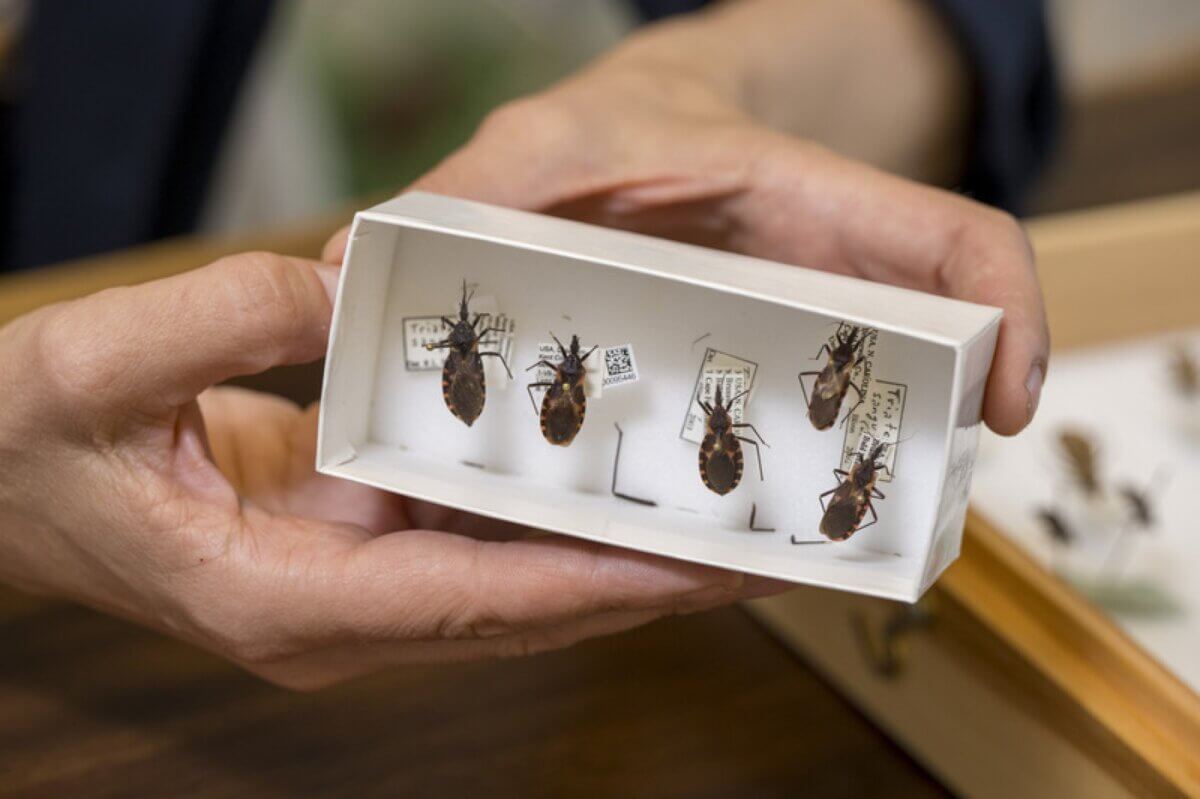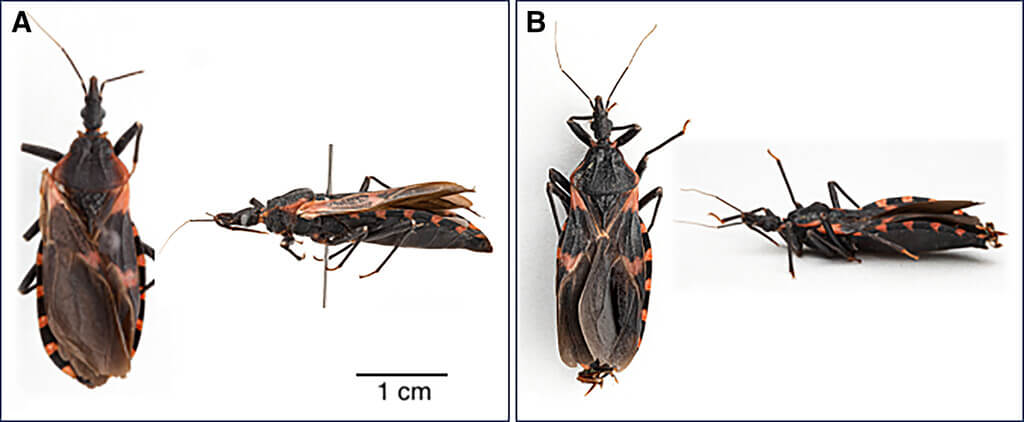
Kissing bugs carry a parasite that causes Chagas disease, which can lead to serious heart problems. (Credit: University of Delaware)
NEWARK, Del. — In a surprising discovery that has raised concerns about an emerging public health threat, researchers have reported the first case of a disease-carrying “kissing virus” discovered in a Delaware home. The insect, known to scientists as Triatomine leechwas not only present in the house but also tested positive for Trypanosoma cruzi – the parasite responsible for Chagas disease.
This observation, published in the American Journal of Tropical Medicine and Hygienehighlights potential gaps in public health awareness and preparedness in the northeastern United States.
Chagas disease, although little known in the United States, affects millions of people in Latin America and is considered a neglected tropical disease by the World Health Organization. The disease can lead to serious heart and digestive problems if left untreated. Although cases of Chagas disease contracted in the United States are rare, this finding suggests that the risk may be higher than previously thought, particularly in areas where the presence of the kissing bug has gone unnoticed or understudied.
The case took place in New Castle County, the northernmost and most densely populated region of Delaware. A homeowner discovered two live adult male bedbugs in his home – one on a bedroom pillow in July 2023 and another in the kitchen in October of the same year. The discovery sparked a months-long journey for the owner, who struggled to obtain accurate information and proper testing for the insects and himself.
What makes this case particularly notable is that one of the bugs tested positive for Trypanosoma cruziThis is the first recorded case of an infected stink bug in Delaware, raising questions about the prevalence of the parasite in local wildlife populations and the potential risk to human health.
“It’s not surprising that he was infected,” Jennifer Peterson, a UD assistant professor and medical entomologist, said in a news release. “Rather, this is a wake-up call that this bug needs to be investigated.”
The owner’s experience also highlights a critical issue: the lack of awareness and preparation among healthcare providers and public health officials when it comes to dealing with these insects and the potential for transmission of Chagas disease in areas where it is not usually expected.
“If there isn’t enough food in the forest and a kissing bug sees twinkling lights coming from someone’s house, it will fly around and see if there is a meal,” warns Peterson.


Summary of the document
Methodology
The researchers used a multifaceted approach to study this case. Their methodology involved several key steps to thoroughly examine the situation. Initially, the insects were identified by the homeowner and then confirmed by University of Delaware entomologists as Triatoma sanguisuga. Both insects were tested for T.cruzi using real-time PCR (qPCR) techniques to determine if they carried the parasite.
To understand the context of the insect’s presence, the researchers conducted a detailed environmental assessment. They collected information about the construction of the house, the surrounding environment and potential wildlife hosts in the area. This comprehensive approach provided a picture of the ecological factors likely to contribute to the presence of kissing bugs in the region.
The study also included a medical monitoring component. The owner underwent testing for T.cruzi antibodies in a commercial diagnostic laboratory to determine if they had been infected with the parasite.
Finally, the researchers documented and analyzed the response of public health authorities to this incident. They carefully recorded the owner’s experience in seeking information and assistance from various health and pest control entities. This documentation provided valuable information on the current state of preparedness and awareness for kissing bugs and Chagas disease in the region.
Key results
The study results paint a complex picture of an emerging public health problem. The discovery of two adult male T. sanguisuga inside a well-kept home in New Castle County, Delaware, was significant because this area had not previously been reported in the scientific literature as part of the distribution area of the species.
Even more alarming, one of the two insects tested positive for Trypanosoma cruzi, confirming the presence of the Chagas disease parasite in the local kissing bug population. This result raises concerns about the potential for disease transmission in the region.
The environmental assessment found that the house was located in an area made up of a mixture of estates, agricultural land and fragments of forest. This diverse landscape provides potential habitats for both insects and their wild hosts, suggesting that the conditions for a T.cruzi A cycle of transmission may exist in the region.
From a human health perspective, even if the owner’s test came back negative T.cruzi antibodies, they reported experiencing unusual stings and heart palpitations around the time the bug was discovered. These symptoms, while not definitively insect-related, highlight the potential health problems associated with the presence of kissing bugs.
Perhaps most telling is that the owner’s attempt to obtain information and testing revealed significant gaps in local knowledge and preparedness for managing kissing bugs and potential exposure to kissing bugs. Chagas. This finding highlights the need for improved education and protocols in areas where these insects are not typically expected.
Limitations of the study
The researchers acknowledged several limitations to their study. The small sample size, with only two insects available for testing, limited the ability to determine the overall prevalence of T.cruzi in the local kissing bug population. Additionally, the study’s focus on a single household in one county makes it difficult to generalize the results to the entire region.
Another limitation was the lack of testing on local wildlife to T.cruzi, which could have provided valuable information on the presence of the parasite in potential reservoir species. The study also did not include long-term monitoring of the home or surrounding area for the continued presence of kissing bugs or T.cruzI infections.
Finally, although the study highlighted gaps in the public health response, it did not provide a comprehensive assessment of state and local government preparedness for kissing bugs and disease. of Chagas. This broader assessment could have provided more context to the difficulties observed in responding to this incident.
Discussion and takeaways
This case study has several important implications for public health, medical practice, and future research. The presence of kissing bugs in New Castle County suggests that the species’ range may be expanding northward, likely due to factors such as climate change or habitat modification. The detection of T.cruzi the presence of one of the insects indicates that the parasite is circulating in the local environment, probably among wild hosts.
The difficulty for owners in obtaining accurate information and appropriate testing highlights the need for increased awareness and education of health care providers and public health officials in areas where bedbugs Kissing is generally not expected. The insects’ ability to enter a well-maintained home suggests that traditional risk factors for kissing bug infestations may not apply in all cases, necessitating a reevaluation of prevention strategies.
The study highlights the importance of implementing systematic surveillance for kissing bugs and T.cruzi in areas where they are not traditionally monitored. It also illustrates the interdependence of human, animal and environmental health, highlighting the need for a One Health approach to combating vector-borne diseases like Chagas.
For healthcare providers in the northeastern United States, this case suggests that they may need to consider Chagas disease as a potential diagnosis in patients with compatible symptoms and potential exposure to kissing bugs. The study also highlights several areas for future research, including the ecology of kissing bugs in the Northeast, T.cruzi prevalence in local wildlife and the development of more effective public health responses to kissing bug encounters.
The discovery of a T.cruzThe kissing virus infected by i in a Delaware home serves as a wake-up call to public health officials, health care providers and researchers. As climate change and habitat alterations continue to alter the range of disease vectors, it is critical that we remain vigilant and adaptable in our approach to emerging infectious disease threats.